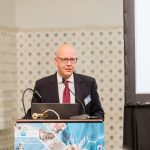25 years of Parque das Nações – how Expo ‘98 led to Portugal redefining its legacy with the oceans
A Danish ambassador, who had been selected to work for the UN lecturing on, reviewing and studying international exhibitions, once said that the urban regeneration project at Parque das Nações in Lisbon, which grew out of Portugal’s World Expo1998, was one of the most successful anywhere in the world*.
In fact, experts from all over the world still visit Lisbon to this day to see the Expo’98 site and understand the secret of its success and why the Portuguese example of an universal exhibition set the standard for the rest of the world.
Three experts, all closely involved in the project at the time, architect João Luís Carrilho da Graça who designed the Science Pavilion and street furniture, landscape architect João Gomes da Silva who helped design the public spaces, and Tiago Pita e Cunha, CEO of Oceano Azul Foundation reflected on different aspects of the Expo ’98 project at an event organised by the American Club of Lisbon and Martinhal Residences/EDU Hub at the lovely setting of the Terrace Restaurant – Martinhal Oriente* (Part of a branded residences and hotel development from the Martinhal Group*) on September 12.
Expo ’98 and what would develop into Parque das Nações, which celebrates its 25th anniversary this year, is an urban regeneration project that created a new district in East Lisbon that today includes housing developments, office parks, administrative buildings; including the city’s main law courts; a shopping centre, casino, a railway and buss station terminus, metro station, shops, hotels, an international school and education hub, and a riverside park with some of the loveliest walkways along the River Tagus estuary to be seen in the city.
A project 10 years in the making
As Chitra Stern, co-founder of the Martinhal Group with husband Roman Stern, pointed out: “Many people don’t know that the genesis of the project started in the late 1980s when the government of Portugal put a bid forward for the World Expo just after Portugal joined the European Union in 1986”.
Portugal was awarded the Expo in 1992 and what happened between 1992 and 1998 was a “tremendous feat” and would go on to be recognised by the Paris-based Bureau International de Expositions as one of the best world expos ever, attracting 10.1 million visitors from all over the world, although the organisers had reckoned for up to 15 million.
A whole area of industrial wasteland, which included abandoned factories and an oil refinery, was cleaned up and prepared to host the World Expo in 1998. The project included the privately financed Vasco da Gama Bridge that at the time was the longest bridge in Europe (17.2 km).
The financing today via a build-operate-transfer system by Lusoponte, a private consortium that receives the first 40 years of tolls for both Lisbon bridges. Lusoponte’s capital is 50.4% from Portuguese companies, 24.8% from French, and 24.8% from British. However, at the time it was built the bridge received funds from the European Union Cohesion Fund (€319m) while the European Investment Bank granted a loan of €299m. Other sources like shareholders and government grants funded €229m. Approximately €50m came from the toll collected at the 25 Abril Bridge.
The World Expo was opened on May 22, 1998, and its development is covered by a documentary ‘Cidade Imaginada’ (A City Imagined) from public broadcaster RTP that interviewed the key players at the time including the architect of the Oceanarium, Peter Chermayeff, the Atlantic Pavilion (Regino Cruz) and the Oriente Station and Bus Terminal infrastructures (Santiago Calatrava).
The idea to organise the Expo ’98 came from António Mega Ferreira – a writer, poet, journalist, and Portuguese cultural manager, and politician and writer Vasco Graça Moura, and was supported by former Portuguese president Jorge Sampaio and architect Manuel Salgado who designed the public spaces after having already blazed a trail with the impressive Belém Cultural Centre in the West of the city that today houses one of the most important collections of modern art in Europe, the Berardo Collection.
The first commission for Expo ’98 was headed by António Cardoso e Cunha (later replaced by José de Melo Torres Campos).
In the words of Chitra Stern: “Today Parque das Nações is a vibrant and modern district that beautifully blends contemporary architecture with natural beauty along the banks of the Tagus River. It is a thriving urban hub and stands as a testament to urban planning, featuring an outstanding urban waterfront walk, esplanades (lined with cafés, restaurants and bars), futuristic buildings designed by world-class architects. It has amazing artwork, murals, sculptures and special tile work throughout”.
A project that has endured
Parque das Nações is also an area of commerce with multinational companies such as Microsoft and Vodafone have their main offices. It is also the site of Lisbon’s main trade fair complex Feira Internacional de Lisboa (FIL) that organises a wide range of business and industrial sector fairs throughout the year.
Its lively atmosphere is accentuated by a number of restaurants, bars and shops, cultural venues, the award-winning Oceanarium and the Science Museum (Pavilhão do Conhecimento).
Today, Parque das Nações has around 22,000 residents, and the most emblematic concert venue in Lisbon, the Altice Arena, which while not famous for its acoustics, hosted around 150 events in 2019, saw over 1 million people attending various events including music concerts and fairs as well as hosting the Eurovision Song Contest in 2018.
The Web Summit, hosted more than 71,000 people from 160 countries in 2022 occupied both the Altice Area and FIL, while the Oceanarium hosted over 1.2 million visitors last year, and Lisbon Casino attracted around 1.5 million. Vasco da Gama Shopping has 170 shops over an 49,000m2 area while its daily footfall totals thousands per day.
There are 2,900 companies based at Parque das Nações – all of this on a site that was cleaned, planned and built in less than a decade.
“I live here today and I love this area. It is the perfect example of a 15-minute city and I’ve doubled my average daily step count since I moved because everywhere is within walking distance,” said Chitra Stern who developed the ULIS (United Lisbon International School, EDU Hub (Education Hub), Martinhal Oriente and ground-breaking, award-winning Ageas office building on the site.
Tiago Pita e Cunha, CEO of the Oceano Azul Foundation since 2017 and for two decades has advocated for stronger ocean governance having worked on ocean sustainability for the UN, the European Commission, the Portuguese government and the president of Portugal discussed the theme and vision behind Expo ’98.
“That last Expo of the 20th century represented not only a massive urban regeneration project with the building of a modern city within a city but also the most defining issue for Portugal – the ocean”.
The Oceano Azul Foundation currently has the concession for the Oceanarium and based on is research found that the public perception of the visitor attraction is that it is one of the ‘must-see’ aquariums in the world. Indeed, according to Trip Advisor it was considered for five years the best in the world until 2019, particularly in terms of animal welfare.
“What was interesting is that the public told us that the distinguishing feature of Lisbon Oceanarium was the design. I had always thought design was a plus, I hadn’t considered that it would be a reason to visit it on its own merit,” he said.
“I have visited a lot of aquariums in Europe and most of them are pretty basic with pipes and tanks and no design at all. Design makes all the difference and this disruptive building on the waterfront has already contributed to the Lisbon of the 21st century.”
The Oceans theme
When Portugal considered its bid in 1989 to host the Expo in 1998 a theme had yet to be conceived in the beginning. It was only when Lisbon was neck-to-neck with Toronto in the competition that it was deemed necessary to come up with a central theme that would convince the United Nations that Lisbon should be awarded the expo.
It was then that the Portuguese government decided the theme should be the oceans its role for our collective future.
“We were at the end of the century and the Cold War with a new century around the corner full of possibilities, and the ideas of Japanese-American philosopher Francis Fukuyama who argued that history should be viewed as an evolutionary process, and whose ‘end of history’ philosophy in this sense, meant that liberal democracy is the final form of government for all nations — an idea that seems to be being dismantled in the 2020s.
“We decided the theme should be the oceans and we fought hard in the UN to make sure that the year of the expo in 1998 should be the UN International Year of the Oceans”, he recalled.
“With Expo ’98 tied in with International Year of the Oceans the perception of the oceans was completely transformed”, he said.
Tiago Pita e Cunha pointed out that during the dictatorship the government used the ocean as part of its propaganda, explaining its isolated position in the world as epitomised by dictator António Salazar’s motto “Proudly Alone”.
The ocean was an integral part of the strategy of Portugal being able to be proudly alone because Portugal, as the largest shipbuilder at the time with the 12th largest shining fleet and dominant in fisheries until 1974; it connected the nation with its overseas colonies.
It was the aesthetic on coins, in squares, on public buildings and in statuary until the 1974 revolution when the ocean was relegated to a peripheral importance for 15 years. Something now confined as part of Portugal’s historical heritage of the Heroes of the Sea – the Great Discoverers such as Ferdinand Magellan and Pedro Álvares Cabral.
Now there was a return to Portugal as an Atlantic trading nation with the new aesthetics of Expo ’98 and a new concept of the oceans connected with the future, science, technology, health and well-being that once again allowed Portugal to reconcile itself with the ocean and accept that the ocean should again become a key strategic asset for the nation, a concept that has gradually taken shape since Expo ’98.
Award-winning architect João Luís Carrilho da Graça, who designed the multi-purpose pavilion for Expo ’98 (Now the Science Centre) at the time called the Pavilion for the Knowledge of the Seas also designed the distinctive striped outdoor furniture and planters for the event. “They wanted something joyful.”
The architect has successfully helped to create a seamless continuum in terms of general style along the riverfront from Parque das Nações to Campo das Cebolas, the latter of which he refurbished and reimagined, including the design of the nearby new Lisbon Cruise Terminal.
Landscape architect João Gomes da Silva was involved with a team designing all of the public open spaces for the Expo ’98 area.
The award-winning designer of the famous Serralves Park in Porto and the public spaces surrounding the Cruise Terminal as well as Ribeira das Naus in Lisbon, was closely involved in the Expo ´98 project and worked for five years alongside the architect Manuel Salgado who was the overall master planner of the space and enclosure for which the resulting project won the Valmor Prize in 1998 and the Portuguese Institute of Design Award in 1999.
“The Oceans approach to the Expo was not only traced out in the several pavilions but also in the public spaces that had been developed from an area which prior to that had been one of heavy Industry,” he said.
“It had been a very dense area, full of equipment and manufacturing buildings and had become a highly polluted area resulting no only in dismantling structures but reclaiming the soil along that part of the estuary which is a recognised European wetland habit and natural park”.
Explaining that the Expo site has developed into the fourth urban centre for Lisbon, João Gomes da Silva who was also involved in the post-Expo master plan of the entire area of what was to become Parque das Nações (Park of the Nations), including mapping out zones for housing, shops and offices, said that developing the public space was one of the elements of the development that successfully “articulated both the pavilions for the exposition and the development of the post-Expo areas”.
It is interesting to note that several key figures involved in the Seville Expo in 1992 acted as advisors to help the Expo ’98 planners and architects to avoid the mistakes made by the Seville planners after the area became a largely abandoned ghost town following the end of the Spanish expo, and thereby ensure the Expo ’98 site would have the sustainable afterlife it enjoys today as a vibrant and commercially successful new Lisbon metropolitan district.
“The development of the public space with wide boulevards, a riverside promenade, a water garden, gardens with species brought from all over the world, and over 700 trees was one of the key factors towards the success of the Parque das Nações area we can see today.
The legacy
So what was the legacy of Expo 1998, the last world exposition of the 20th century and first major urban regeneration project in Lisbon since the Avenidas Novas of the 1940s and 1950s?
According to the Bureau International des Expositions, despite the acknowledged success of the event in creating a new and futuristic urban landscape for contemporary living, the urban project also generated several criticisms. On one hand, there was a negative perspective on the culture of “urban entrepreneurship”, competitiveness and the “regime of exception” implemented by the Expo project, with this being viewed as a neoliberal planning approach that prioritised private financial interests and enabled excessive building density.
On the other, the failure to generate social and physical connections with the urban surroundings and to promote the regeneration of the eastern area of Lisbon were pointed out. Like a typical flagship project, the operation concentrated much of the resources and opportunities that could have been distributed to other areas. The physical isolation has reinforced a process of social selectivity at the residential level, hence it has become a middle and upper-class income district, benefiting from a scenario of quality and exclusivity which has become perhaps even more glaring in the light of Lisbon’s current affordable housing crisis.
As to the intangible aspect of rekindling Portugal’s historic relationship with the sea, much has been made of Portugal’s massive maritime economic zone, which considering all parts of its territory, is about 50,957 Km2, 16,460 Km2 of which correspond to the continent’s portion, 23,663 Km2 to the Azores archipelago portion and 10,834 Km2 to the archipelago portion of Madeira.
But I remains to be seen how Portugal can benefit from the Blue Economy in a tangible way and while much is made of Blue Bonds and Blue Investments with some promising noises from certain venture capital entities, there is little to suggest for now that current Portuguese policy plans are anything more than a drop in the ocean.
1* Cited by the President of the American Club of Lisbon, Patrick Siegler-Lathrop who met the ambassador in question.
Text & Photo: Chris Graeme










